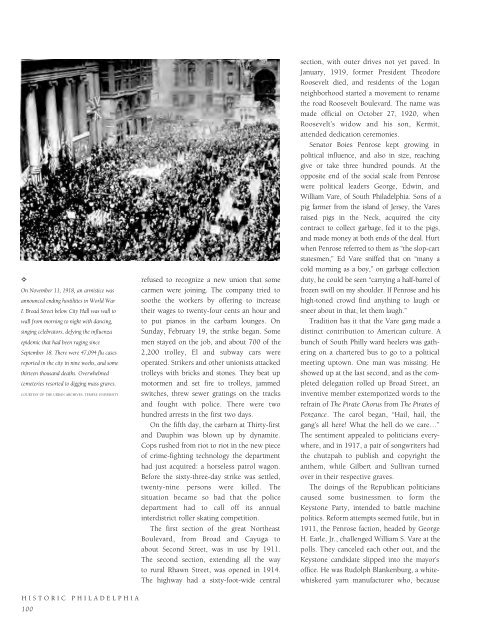Historic Philadelphia
An illustrated history of the city of Philadelphia, paired with the histories of companies, families and organizations that make the region great.
An illustrated history of the city of Philadelphia, paired with the histories of companies, families and organizations that make the region great.
Create successful ePaper yourself
Turn your PDF publications into a flip-book with our unique Google optimized e-Paper software.
✧<br />
On November 11, 1918, an armistice was<br />
announced ending hostilities in World War<br />
I. Broad Street below City Hall was wall to<br />
wall from morning to night with dancing,<br />
singing celebrators, defying the influenza<br />
epidemic that had been raging since<br />
September 18. There were 47,094 flu cases<br />
reported in the city in nine weeks, and some<br />
thirteen thousand deaths. Overwhelmed<br />
cemeteries resorted to digging mass graves.<br />
COURTESY OF THE URBAN ARCHIVES, TEMPLE UNIVERSITY.<br />
HISTORIC PHILADELPHIA<br />
100<br />
refused to recognize a new union that some<br />
carmen were joining. The company tried to<br />
soothe the workers by offering to increase<br />
their wages to twenty-four cents an hour and<br />
to put pianos in the carbarn lounges. On<br />
Sunday, February 19, the strike began. Some<br />
men stayed on the job, and about 700 of the<br />
2,200 trolley, El and subway cars were<br />
operated. Strikers and other unionists attacked<br />
trolleys with bricks and stones. They beat up<br />
motormen and set fire to trolleys, jammed<br />
switches, threw sewer gratings on the tracks<br />
and fought with police. There were two<br />
hundred arrests in the first two days.<br />
On the fifth day, the carbarn at Thirty-first<br />
and Dauphin was blown up by dynamite.<br />
Cops rushed from riot to riot in the new piece<br />
of crime-fighting technology the department<br />
had just acquired: a horseless patrol wagon.<br />
Before the sixty-three-day strike was settled,<br />
twenty-nine persons were killed. The<br />
situation became so bad that the police<br />
department had to call off its annual<br />
interdistrict roller skating competition.<br />
The first section of the great Northeast<br />
Boulevard, from Broad and Cayuga to<br />
about Second Street, was in use by 1911.<br />
The second section, extending all the way<br />
to rural Rhawn Street, was opened in 1914.<br />
The highway had a sixty-foot-wide central<br />
section, with outer drives not yet paved. In<br />
January, 1919, former President Theodore<br />
Roosevelt died, and residents of the Logan<br />
neighborhood started a movement to rename<br />
the road Roosevelt Boulevard. The name was<br />
made official on October 27, 1920, when<br />
Roosevelt’s widow and his son, Kermit,<br />
attended dedication ceremonies.<br />
Senator Boies Penrose kept growing in<br />
political influence, and also in size, reaching<br />
give or take three hundred pounds. At the<br />
opposite end of the social scale from Penrose<br />
were political leaders George, Edwin, and<br />
William Vare, of South <strong>Philadelphia</strong>. Sons of a<br />
pig farmer from the island of Jersey, the Vares<br />
raised pigs in the Neck, acquired the city<br />
contract to collect garbage, fed it to the pigs,<br />
and made money at both ends of the deal. Hurt<br />
when Penrose referred to them as “the slop-cart<br />
statesmen,” Ed Vare sniffed that on “many a<br />
cold morning as a boy,” on garbage collection<br />
duty, he could be seen “carrying a half-barrel of<br />
frozen swill on my shoulder. If Penrose and his<br />
high-toned crowd find anything to laugh or<br />
sneer about in that, let them laugh.”<br />
Tradition has it that the Vare gang made a<br />
distinct contribution to American culture. A<br />
bunch of South Philly ward heelers was gathering<br />
on a chartered bus to go to a political<br />
meeting uptown. One man was missing. He<br />
showed up at the last second, and as the completed<br />
delegation rolled up Broad Street, an<br />
inventive member extemporized words to the<br />
refrain of The Pirate Chorus from The Pirates of<br />
Penzance. The carol began, “Hail, hail, the<br />
gang’s all here! What the hell do we care…”<br />
The sentiment appealed to politicians everywhere,<br />
and in 1917, a pair of songwriters had<br />
the chutzpah to publish and copyright the<br />
anthem, while Gilbert and Sullivan turned<br />
over in their respective graves.<br />
The doings of the Republican politicians<br />
caused some businessmen to form the<br />
Keystone Party, intended to battle machine<br />
politics. Reform attempts seemed futile, but in<br />
1911, the Penrose faction, headed by George<br />
H. Earle, Jr., challenged William S. Vare at the<br />
polls. They canceled each other out, and the<br />
Keystone candidate slipped into the mayor’s<br />
office. He was Rudolph Blankenburg, a whitewhiskered<br />
yarn manufacturer who, because
















